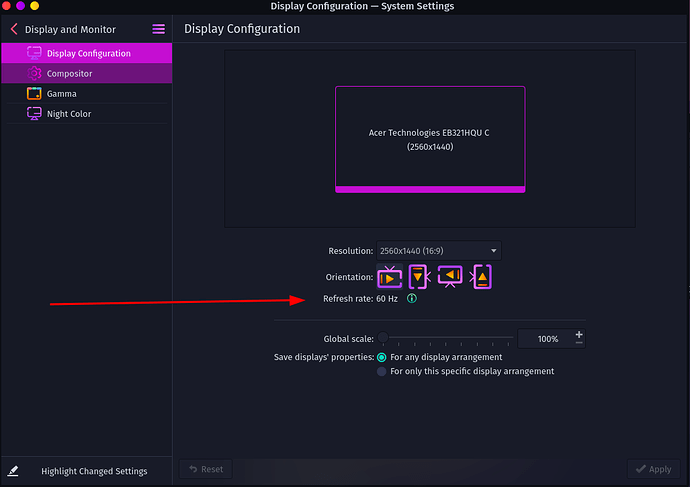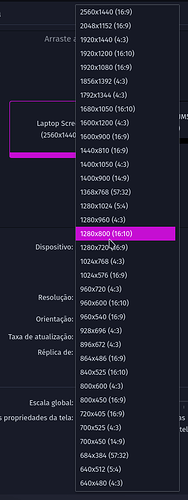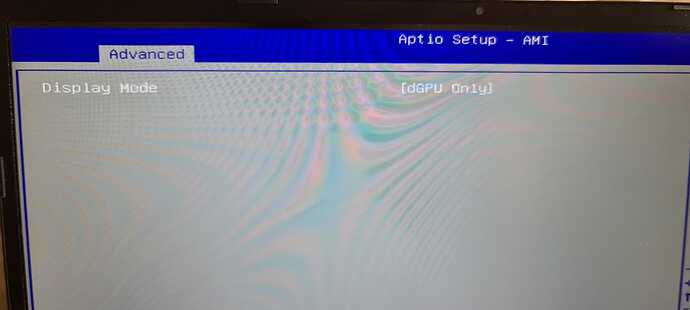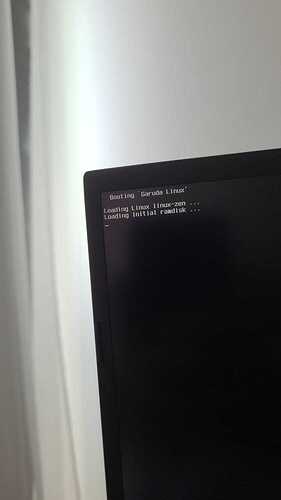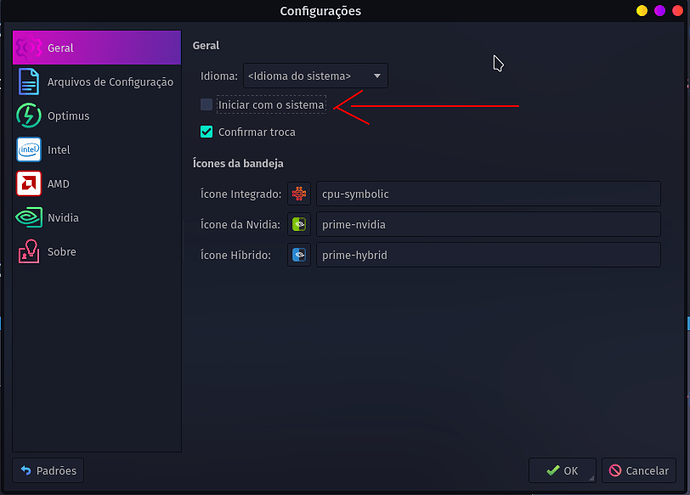hello
i am trying to set refresh rate of my laptop because its stuck at 40hz without any success
i did try editing ~/.local/share/kscreen/* and setting the hz to 165 but it reverts on reboot and never actually works
i did try
cvt 2560 1440 165
xrandr --newmode "2560x1440_165.00" 938.50 2560 2792 3072 3584 1440 1443 1448 1588 -hsync +vsync
xrandr --addmode eDP-1 2560x1440_165.00
xrandr --output eDP-1 --mode "2560x1440_165.00"
screen blinks for a bit but its still 40hz after
garuda-inxi
System:
Kernel: 5.17.1-zen1-1-zen arch: x86_64 bits: 64 compiler: gcc v: 11.2.0
parameters: BOOT_IMAGE=/@/boot/vmlinuz-linux-zen
root=UUID=9e5f3ce0-1150-45df-9ae2-1df2dc564966 rw rootflags=subvol=@
quiet quiet splash rd.udev.log_priority=3 vt.global_cursor_default=0
resume=UUID=771f3b39-4d0e-49cc-8cb6-7480bd60c7cf loglevel=3
Desktop: KDE Plasma v: 5.24.4 tk: Qt v: 5.15.3 info: latte-dock
wm: kwin_x11 vt: 1 dm: SDDM Distro: Garuda Linux base: Arch Linux
Machine:
Type: Laptop System: SchenkerGmbH product: XMG NEO (TGL/M21) v: Standard
serial: <superuser required>
Mobo: NB02 model: GMxTGxx v: Standard serial: <superuser required>
UEFI: American Megatrends LLC. v: N.1.07A02 date: 09/07/2021
Battery:
ID-1: BAT0 charge: 93.5 Wh (100.0%) condition: 93.5/93.5 Wh (100.0%)
volts: 12.9 min: 11.4 model: standard type: Li-ion serial: <filter>
status: full
CPU:
Info: model: 11th Gen Intel Core i7-11800H bits: 64 type: MT MCP
arch: Tiger Lake family: 6 model-id: 0x8D (141) stepping: 1 microcode: 0x3C
Topology: cpus: 1x cores: 8 tpc: 2 threads: 16 smt: enabled cache:
L1: 640 KiB desc: d-8x48 KiB; i-8x32 KiB L2: 10 MiB desc: 8x1.2 MiB
L3: 24 MiB desc: 1x24 MiB
Speed (MHz): avg: 2281 high: 4500 min/max: 800/4600 scaling:
driver: intel_pstate governor: powersave cores: 1: 2780 2: 1306 3: 2177
4: 1594 5: 2243 6: 3884 7: 1727 8: 801 9: 2529 10: 3157 11: 829 12: 4500
13: 1410 14: 3255 15: 1072 16: 3235 bogomips: 73728
Flags: avx avx2 ht lm nx pae sse sse2 sse3 sse4_1 sse4_2 ssse3 vmx
Vulnerabilities:
Type: itlb_multihit status: Not affected
Type: l1tf status: Not affected
Type: mds status: Not affected
Type: meltdown status: Not affected
Type: spec_store_bypass
mitigation: Speculative Store Bypass disabled via prctl
Type: spectre_v1
mitigation: usercopy/swapgs barriers and __user pointer sanitization
Type: spectre_v2
mitigation: Enhanced IBRS, IBPB: conditional, RSB filling
Type: srbds status: Not affected
Type: tsx_async_abort status: Not affected
Graphics:
Device-1: Intel TigerLake-H GT1 [UHD Graphics] vendor: Tongfang Hongkong
driver: i915 v: kernel ports: active: eDP-1 empty: DP-1 bus-ID: 00:02.0
chip-ID: 8086:9a60 class-ID: 0300
Device-2: NVIDIA GA106M [GeForce RTX 3060 Mobile / Max-Q]
vendor: Tongfang Hongkong driver: nvidia v: 510.60.02
alternate: nouveau,nvidia_drm pcie: gen: 1 speed: 2.5 GT/s lanes: 16
link-max: gen: 4 speed: 16 GT/s ports: active: none
empty: DP-2, DP-3, HDMI-A-1, eDP-2 bus-ID: 01:00.0 chip-ID: 10de:2520
class-ID: 0300
Device-3: Chicony HD Webcam type: USB driver: uvcvideo bus-ID: 3-13:4
chip-ID: 04f2:b71a class-ID: 0e02 serial: <filter>
Display: x11 server: X.Org v: 21.1.3 with: Xwayland v: 22.1.1
compositor: kwin_x11 driver: X: loaded: modesetting,nvidia gpu: i915
display-ID: :0 screens: 1
Screen-1: 0 s-res: 2560x1440 s-dpi: 96 s-size: 677x381mm (26.65x15.00")
s-diag: 777mm (30.58")
Monitor-1: eDP-1 model: BOE Display 0x0974 built: 2020 res: 2560x1440
hz: 40 dpi: 189 gamma: 1.2 size: 344x194mm (13.54x7.64")
diag: 395mm (15.5") ratio: 16:9 modes: 2560x1440
OpenGL: renderer: Mesa Intel UHD Graphics (TGL GT1) v: 4.6 Mesa 22.0.1
direct render: Yes
Audio:
Device-1: Intel Tiger Lake-H HD Audio vendor: Tongfang Hongkong
driver: snd_hda_intel v: kernel alternate: snd_sof_pci_intel_tgl
bus-ID: 00:1f.3 chip-ID: 8086:43c8 class-ID: 0403
Device-2: NVIDIA vendor: Tongfang Hongkong driver: snd_hda_intel
v: kernel pcie: gen: 1 speed: 2.5 GT/s lanes: 16 link-max: gen: 4
speed: 16 GT/s bus-ID: 01:00.1 chip-ID: 10de:228e class-ID: 0403
Sound Server-1: ALSA v: k5.17.1-zen1-1-zen running: yes
Sound Server-2: PulseAudio v: 15.0 running: no
Sound Server-3: PipeWire v: 0.3.49 running: yes
Network:
Device-1: Intel Tiger Lake PCH CNVi WiFi driver: iwlwifi v: kernel
bus-ID: 00:14.3 chip-ID: 8086:43f0 class-ID: 0280
IF: wlo1 state: down mac: <filter>
Device-2: Realtek RTL8125 2.5GbE vendor: Tongfang Hongkong driver: r8169
v: kernel pcie: gen: 2 speed: 5 GT/s lanes: 1 port: 3000 bus-ID: 2e:00.0
chip-ID: 10ec:8125 class-ID: 0200
IF: enp46s0 state: up speed: 1000 Mbps duplex: full mac: <filter>
Bluetooth:
Device-1: Intel AX201 Bluetooth type: USB driver: btusb v: 0.8
bus-ID: 3-14:5 chip-ID: 8087:0026 class-ID: e001
Report: bt-adapter ID: hci0 rfk-id: 0 state: up address: <filter>
Drives:
Local Storage: total: 1.82 TiB used: 151.27 GiB (8.1%)
SMART Message: Unable to run smartctl. Root privileges required.
ID-1: /dev/nvme0n1 maj-min: 259:0 vendor: Seagate
model: FireCuda 510 SSD ZP1000GM30001 size: 931.51 GiB block-size:
physical: 512 B logical: 512 B speed: 31.6 Gb/s lanes: 4 type: SSD
serial: <filter> rev: STES1024 temp: 36.9 C scheme: GPT
ID-2: /dev/sda maj-min: 8:0 type: USB vendor: Samsung model: PSSD T7
size: 931.51 GiB block-size: physical: 512 B logical: 512 B type: SSD
serial: <filter> scheme: GPT
SMART Message: Unknown USB bridge. Flash drive/Unsupported enclosure?
Partition:
ID-1: / raw-size: 897.01 GiB size: 897.01 GiB (100.00%)
used: 151.27 GiB (16.9%) fs: btrfs dev: /dev/sda2 maj-min: 8:2
ID-2: /boot/efi raw-size: 300 MiB size: 299.4 MiB (99.80%)
used: 576 KiB (0.2%) fs: vfat dev: /dev/sda1 maj-min: 8:1
ID-3: /home raw-size: 897.01 GiB size: 897.01 GiB (100.00%)
used: 151.27 GiB (16.9%) fs: btrfs dev: /dev/sda2 maj-min: 8:2
ID-4: /var/log raw-size: 897.01 GiB size: 897.01 GiB (100.00%)
used: 151.27 GiB (16.9%) fs: btrfs dev: /dev/sda2 maj-min: 8:2
ID-5: /var/tmp raw-size: 897.01 GiB size: 897.01 GiB (100.00%)
used: 151.27 GiB (16.9%) fs: btrfs dev: /dev/sda2 maj-min: 8:2
Swap:
Kernel: swappiness: 133 (default 60) cache-pressure: 100 (default)
ID-1: swap-1 type: partition size: 34.21 GiB used: 0 KiB (0.0%)
priority: -2 dev: /dev/sda3 maj-min: 8:3
ID-2: swap-2 type: zram size: 31.1 GiB used: 0 KiB (0.0%) priority: 100
dev: /dev/zram0
Sensors:
System Temperatures: cpu: 55.0 C mobo: 55.0 C
Fan Speeds (RPM): N/A
Info:
Processes: 348 Uptime: 5m wakeups: 69 Memory: 31.1 GiB
used: 3.24 GiB (10.4%) Init: systemd v: 250 tool: systemctl Compilers:
gcc: 11.2.0 clang: 13.0.1 Packages: pacman: 2110 lib: 404 Shell: fish
v: 3.4.1 default: Bash v: 5.1.16 running-in: konsole inxi: 3.3.15
Garuda (2.6.1-1):
System install date: 2022-04-10
Last full system update: 2022-04-10
Is partially upgraded: No
Relevant software: NetworkManager
Windows dual boot: Probably (Run as root to verify)
Snapshots: Snapper
Failed units:
